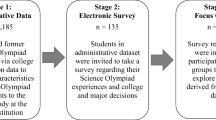Abstract
The goal of this study is to examine whether participation in high school research apprenticeships increases pursuit of degrees and careers in science, and to explore other apprenticeship benefits. Students who participated in a research apprenticeship were surveyed about its influence on their undergraduate, graduate, and professional decisions. A control group who attended the same high schools, had similar grade point averages, and graduated with the apprenticeship participants was also surveyed. It was found that a significantly higher fraction of the apprenticeship group majored in Science, Math, Engineering, and Technology (STEM) fields, pursued careers in STEM disciplines, and found the experience to strategically influence their job performance.










Similar content being viewed by others
References
National Science Foundation: Science and Engineering Indicators 2016. NSB-201601 (2016). Available at: https://www.nsf.gov/statistics/2016/nsb20161/#/report (accessed November 2017).
L.G. Paldy: No time for complacency. J. Coll. Scl. Teach. 35, 4–5 (2005).
G.M. Nicholls, H. Wolfe, M. Besterfield-Sacre, L.J. Shuman, and S. Larpkiattaworn: A method for identifying variables for predicting STEM enrollment. J. Eng. Educ. 96, 33–44 (2007).
M.A. Cannady, E. Greenwald, and K.N. Harris: Problematizing the STEM pipeline metaphor: is the STEM pipeline metaphor serving our students and the STEM workforce? Sci. Educ. 98, 443–460 (2014).
R.R. Bryan, S.M. Glynn, and J.M. Kittleson: Motivation, achievement, and advanced placement intent of high school students learning science. Sci. Educ. 95, 1049–1065 (2011).
A. Hofstein and V.N. Lunetta: The laboratory in science education: foundations for the twenty-first century. Sci. Educ. 88, 28–54 (2003).
R.H. Tai, C.Q. Liu, A.V. Maltese, and X. Fan: Planning early for careers in science. Science 312, 1143–1144 (2006).
E.C. Kokkelenberg and E. Sinha: Who succeeds in STEM studies? An analysis of Binghamton University undergraduate students. Econ. Educ. Rev. 29, 935–946 (2010).
C. Hall, J. Dickerson, D. Batts, P. Kauffmann, and M. Bosse: Are we missing opportunities to encourage interest in STEM fields? J. Technol. Educ. 23, 32–46 (2011).
M. Sanders: STEM, STEM education, STEMmania. Technol. Teach. 68, 20–25 (2009).
R.E. Bleicher: High school students learning science in university research laboratories. J. Res. Sci. Teach. 33, 1115–1133 (1996).
E. Seymourand N.M. Hewitt: Talking about leaving: why undergraduates leave the sciences (Westview, Boulder, CO, 1997).
R.S. Hathaway, B.R. Nagda, and S.R. Gregerman: The relationship of undergraduate research participation to graduate and professional education pursuit: an empirical study. J. Coll. Stud. Dev 43, 1–18 (2002).
L.M. Abraham: What do high school science students gain from field-based research apprenticeship programs? Clearing House 75, 229–232 (2002).
M.A.R. Townsend and L. Hicks: Classroom goal structures, social satisfaction, and the perceived value of academic tasks. Br. J. Educ. Psychol. 67, 1–12 (1997).
T.D. Sadler, S. Burgin, L. McKinney, and L. Ponjuan: Learning science through research apprenticeships: a critical review of the literature. J. Res. Sci. Teach. 47, 235–256 (2010).
Q. Bui: What’s your major? Decades of college degrees, in 1 graph (2014). NPR. Available at: https://www.npr.org/sections/money/2014/05/09/310114739/whats-your-major-four-decades-of-college-degrees-in-1-graph (accessed November 2017).
S. Baumand P. Steele: Who goes to graduate school and who succeeds? Access Group Inc. and Urban Institute (2017). Available at: https://www.urban.org/sites/default/files/publication/86981/who_goes_to_graduate_ school_and_who_succeeds_0.pdf (accessed November 2017).
US News and World Report: Best colleges (2016). Available at: https://www.usnews.com/best-colleges/rankings/national-universities (accessed November 2017).
ACKNOWLEDGMENTS
Funding for this project was provided by the NSF-Inspire Program Award No. 1344267 and by the Morin Foundation Trust.
Author information
Authors and Affiliations
Corresponding author
Rights and permissions
About this article
Cite this article
Budassi, J., Rafailovich, M. The effect of university research apprenticeships for high school students on Science, Math, Engineering, and Technology learning and the pursuit of Science, Math, Engineering, and Technology degrees and careers. MRS Communications 8, 387–397 (2018). https://doi.org/10.1557/mrc.2018.92
Received:
Accepted:
Published:
Issue Date:
DOI: https://doi.org/10.1557/mrc.2018.92




